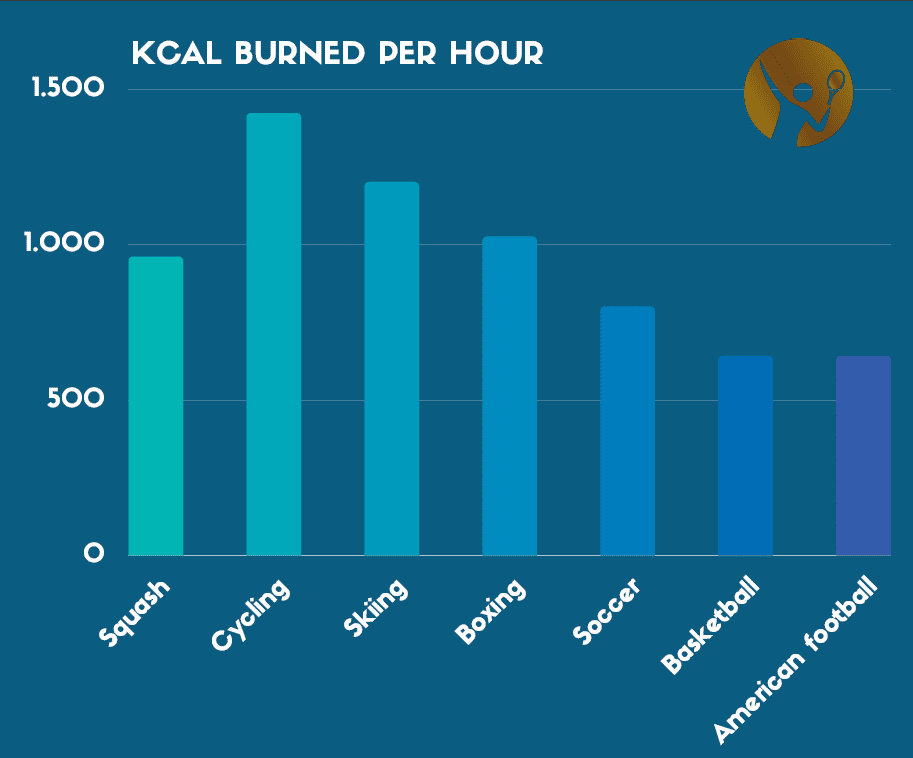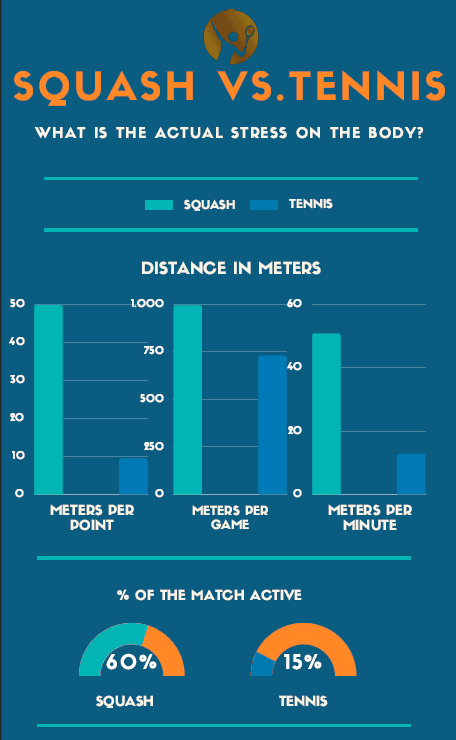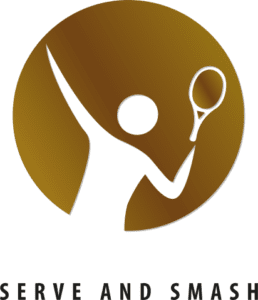This post may contain affiliate links.
How though is squash? The natural question that arises is how to determine whether a sport is tough to play? I have taken a structural approach in answering both these questions.
Squash is the most intense racket sport in terms of calorie expenditure and requires many physiological capabilities. On average, professional players reach a heart rate of 170 bpm, covering around 50 meters per point or 1 km per game while staying active for 60% of the duration of the match.
Rather than only spitting out an arguable number and conclusion, I will substantiate my answer and how I’ve arrived at this conclusion. So let’s start with currently available metrics and compare squash against other sports. Subsequently, I will back it up with my own analysis.
If you are impatient or looking for a specific answer, navigate directly to the answers to one of these questions:
- Is squash the most intense sport?
- What racket sport burns most calories?
- Squash the healthiest sport, wait what?
- How fit do you have to be to play squash?
- What physiological capabilities are needed for squash?
Is squash the most intense sport?

Squash is in the top 10 of the most intense sports when measured by the number of calories burned. All things equal, squash burns 12 times more calories than at rest.
For the sake of simplicity let’s classify a sport as intense and tough based upon the number of calories you burn per hour. In the table below you’ll find the number of calories burned for someone weighing 80 kilograms / 176 lbs. This number assumes the activity is performed continuously for one hour.
But before you get too hung up about the numbers themselves, hold on! While these numbers are based upon scientific research, there are factors such as metabolism and conditioning that can definitely impact these numbers. Therefore all things being equal, we can determine the difference between physical activities. Based upon a more extensive list containing calculated calorie expenditures per hour for any given body weight, squash is in the top 10 of most intense sports.
| Sport | Kcal burned per hour* |
|---|---|
| Squash | 960 |
| Cycling >20 mph | 1422 |
| Skiing >8.0 mph | 1200 |
| Boxing | 1024 |
| Soccer | 800 |
| Basketball | 640 |
| American football | 640 |
What racket sport burns most calories?
Squash burns the most calories per hour on both a competitive and recreational level compared to other racket sports. The average number of calories burned proportionally increases with bodyweight.
The sports mentioned earlier are quite diverse in the movements performed. During cycling, you will not engage your upper body as much as squash or basketball for example. Limiting our focus to racket sports only seems valuable to get a grasp of the intensity of squash. I hear you think, there is a difference in intensity between playing at a recreational level or a competitive level. Indeed, therefore we will look at them separately. Sounds reasonable, right?
If we focus only on racket sports on a competitive level, we can conclude squash burns the most calories per hour for any given body weight.
| Racket sport | 50 kg 110 lbs | 60 kg 132 lbs | 70 kg 154 lbs | 80 kg 176 lbs | 90 kg 198 lbs | 100 kg 220 lbs | 110 kg 243 lbs | 120 kg 265 lbs |
|---|---|---|---|---|---|---|---|---|
| Squash | 600 | 720 | 840 | 960 | 1080 | 1200 | 1320 | 1440 |
| Badminton | 350 | 420 | 490 | 560 | 630 | 700 | 770 | 840 |
| Padel / Paddleball | 500 | 600 | 700 | 800 | 900 | 1000 | 1100 | 1200 |
| Racquetball | 500 | 600 | 700 | 800 | 900 | 1000 | 1100 | 1200 |
| Tennis singles | 400 | 480 | 560 | 640 | 720 | 800 | 880 | 960 |
| Tennis doubles | 300 | 360 | 420 | 480 | 540 | 600 | 660 | 720 |
| Table tennis | 200 | 240 | 280 | 320 | 360 | 400 | 440 | 480 |
| Lacrosse | 400 | 480 | 560 | 640 | 720 | 800 | 880 | 960 |
If we then turn to racket sports on a recreational level, squash and tennis (singles) both burn the most calories per hour for any given body weight.
| Racket sport | 50 kg 110 lbs | 60 kg 132 lbs | 70 kg 154 lbs | 80 kg 176 lbs | 90 kg 198 lbs | 100 kg 220 lbs | 110 kg 243 lbs | 120 kg 265 lbs |
|---|---|---|---|---|---|---|---|---|
| Squash | 365 | 438 | 511 | 584 | 657 | 730 | 803 | 876 |
| Badminton | 275 | 330 | 385 | 440 | 495 | 550 | 605 | 660 |
| Padel / Paddleball | 300 | 360 | 420 | 480 | 540 | 600 | 660 | 720 |
| Racquetball | 350 | 420 | 490 | 560 | 630 | 700 | 770 | 840 |
| Tennis singles | 365 | 438 | 511 | 584 | 657 | 730 | 803 | 876 |
| Tennis doubles | 225 | 270 | 315 | 360 | 405 | 450 | 495 | 540 |
Squash the healthiest sport, wait what?
Forbes  did a study years ago to determine the healthiest sport, meaning a sport that helps in reducing the risk of disease. The study is based upon expert interviews where they needed to rank sports (on a five scale rating) alongside the following dimensions: strength, stamina, speed, and flexibility. On top of that, the risk of injury and calorie burn rate was taken into account using a respectively 3 and 5 rate scale. Each sport was ranked based upon the scores given by the experts and guess which sport came out on top? Yes, that is right, squash!
did a study years ago to determine the healthiest sport, meaning a sport that helps in reducing the risk of disease. The study is based upon expert interviews where they needed to rank sports (on a five scale rating) alongside the following dimensions: strength, stamina, speed, and flexibility. On top of that, the risk of injury and calorie burn rate was taken into account using a respectively 3 and 5 rate scale. Each sport was ranked based upon the scores given by the experts and guess which sport came out on top? Yes, that is right, squash!
How fit do you have to be to play squash?
Heart rate
The PSA  gathered together with other companies, heart rates of squash players data during professional matches. They found players were reaching a heart rate of 190-199 bpm (beats per minute) on a regular basis with an average of 171 bpm. In 2019 PSA partnered with Sports Data Labs
gathered together with other companies, heart rates of squash players data during professional matches. They found players were reaching a heart rate of 190-199 bpm (beats per minute) on a regular basis with an average of 171 bpm. In 2019 PSA partnered with Sports Data Labs to incorporate live biometric data into live streaming squash events (on SquashTV). Heart rate is one of these key biometric measures that is tracked and gives the viewer insight into the amount of physical effort the players go through.
to incorporate live biometric data into live streaming squash events (on SquashTV). Heart rate is one of these key biometric measures that is tracked and gives the viewer insight into the amount of physical effort the players go through.
Stress on the body

The amount is stress on the body is hard to capture, since it involves multiple elements. InteractiveSquash, a company that manufactures interactive squash courts, tracked several professional squash players. To give you an idea of the amount of stress on the body, consider this: move 49 meters for every point in a game that lasts 100 points while hitting the ball 1000 times. This seems a lot more impressive than 5 kilometers in 97 minutes, I would say!
Let’s compare this to another racket sport, tennis. In this case , the professional tennis player that was tracked moved 3.6 kilometers in 288 minutes. When comparing these two examples, squash seems more stressful on the body, but wait until you hear the amount of time these two players were actually moving. While the squash player was active 60% of the duration of the match, the tennis player was only 15% of the time!
, the professional tennis player that was tracked moved 3.6 kilometers in 288 minutes. When comparing these two examples, squash seems more stressful on the body, but wait until you hear the amount of time these two players were actually moving. While the squash player was active 60% of the duration of the match, the tennis player was only 15% of the time!
What physiological capabilities are needed for squash?
Squash is a fast-moving game where you need to anticipate where the ball will go and position yourself accordingly. This involves the following physiological capabilities: speed, strength, coordination, agility, flexibility, endurance, and balance.
The physiological capability speed consists of the ability to move your body parts quickly. Think about short intense sprints of two to five meters to return the ball.

Strength contains both upper body and lower body strength. Upper body strength is needed to hit the ball with sufficient power using your racket. Lower body strength, on the other hand, is needed to move and jump around the court. Strength has the benefit of increasing both the condition of your muscles and bones.
Coordination is the ability to move all of your body parts together as a whole. In squash, you need to watch and anticipate the movement of the ball, position yourself and be able to hit the ball. Proper hand-eye coordination is needed to ensure you are not tripping over your own feet while positioning and anticipating the movement of the ball.
Agility is the ability to quickly react rather than just quickly moving (as is the case with speed). In squash, this capacity is important, since it allows you to anticipate where the ball will go position yourself accordingly and move back to the corner. Besides, movements are both forward as well as backward.
Flexibility is the ability to extend yourself (and your muscles) through movements like lunges in order to reach farther. If you increase your flexibility, you’ll reduce the risk of injury. Again, this aspect was also part of the ranking mentioned earlier, where squash was considered the healthiest sport.
Endurance and stamina allow you to keep going without getting exhausted. As we have seen earlier, squash is an intense sport. This ability can be enhanced using conditioning drills.
Balance allows you to remain standing even if your body is imbalanced. In order to correct this imbalance (during a movement), the muscles in your core need to work. Balance and stability help to improve your posture and reduce (low) back pain.
This involves the following physiological capabilities: speed, strength, coordination, agility, flexibility, endurance, and balance.

